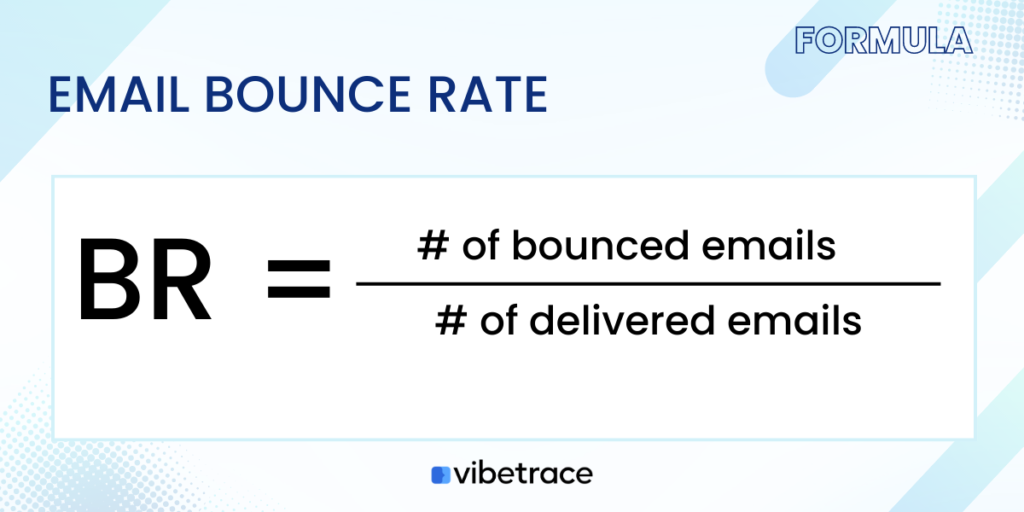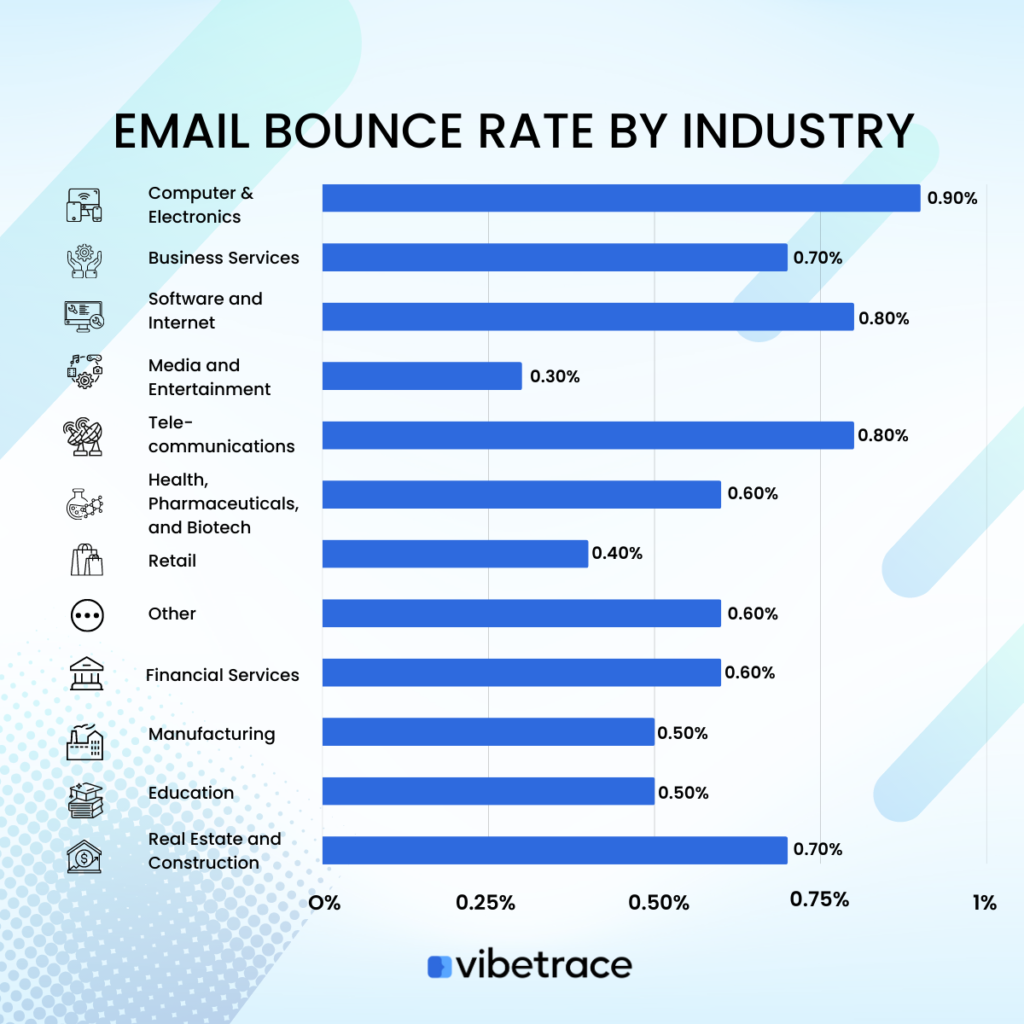Email Bounce Rate is one of the known metrics used by businesses to check the quality of emails and how well they comply with the rules of email.
You probably have felt frustrated about seeing bounced emails when an email is returned because it cannot be delivered to your desired recipient. And you marketing automation workflows will suffer from this!
In fact, these bounced emails represent missed opportunities to connect with potential customers, which would really make you think again.
By understanding your Email Bounce Rate, it will be easier for you to improve the deliverability of your business’ messages and increase their chances of connecting with your target audience.
What is Email Bounce Rate?
Definition of Email Bounce Rate
Email bounce rate refers to the percentage of emails sent that are returned to the sender as undeliverable.
This can happen for a variety of reasons, such as a full inbox, an invalid email address, or an email blocked by a spam filter.
A high bounce rate can be a sign of a problem with the email list, such as outdated or inaccurate contact information, and can negatively impact the effectiveness of email marketing campaigns.
To decrease the bounce rate, it’s important to regularly maintain and update the email list, make sure that the email addresses are valid, and follow best practices for avoiding spam filters.
A high bounce rate can damage the domain’s reputation.
There are two types of bounce. Hard bounce and soft bounce. Both bounces have different meanings and purposes.
What is a hard bounce?
A hard bounce is when an email is returned to the sender because the recipient’s email address is incorrect or invalid.
This happens due to a communication issue between the sender and the recipient’s mail servers. The email will be returned to the sender as undelivered if it is rejected by the recipient’s mail server.
Here are a few of the reasons:
- The email address doesn’t exist or is invalid.
- The domain name is invalid or doesn’t exist.
- The email is blocked by the recipient’s spam filters or security measures
- The sender’s IP address or domain is blacklisted, causing the email to be blocked by the recipient’s email server.
- The recipient has closed or deleted their email account.
What is soft bounce?
A soft bounce is an email that is temporarily returned to the sender because the recipient’s email inbox is full, the email server is down, or the email is too large to be delivered. Unlike hard bounces, soft bounces can be resolved by resending the email at a later time. It’s important to monitor the bounce rate and take necessary action to decrease them.
- The recipient’s inbox is full and cannot accept any more emails.
- The recipient’s email server is down or experiencing technical difficulties.
- The email is too large to be delivered and exceeds the recipient’s email server’s size limit.
- The email contains an attachment that is blocked by the recipient’s email server or security measures.
Email Bounce Rate Formula

Email Bounce Rate by Industry
The average email bounce rate percentage for various industries is displayed below.

| INDUSTRY | AVERAGE |
| Media and Entertainment | 0.30% |
| Retail | 0.40% |
| Education | 0.50% |
| Manufacturing | 0.50% |
| Health, Pharmaceuticals, and Biotech | 0.60% |
| Financial Services | 0.60% |
| Other | 0.60% |
| Real Estate and Construction | 0.70% |
| Business Services | 0.70% |
| Software and Internet | 0.80% |
| Telecommunications | 0.80% |
| Computer & Electronics | 0.90% |
The data presents the average hard bounce rate for various industries, as determined by Hubspot.
The media and entertainment industry had the lowest average hard bounce rate at 0.30%, while the computer and electronics industry had the highest at 0.90%.
The retail industry had an average hard bounce rate of 0.40%, while the education, manufacturing, and health, pharmaceuticals, and biotech industries all had an average of 0.50%.
The financial services, other, real estate and construction, and business services industries all had an average hard bounce rate of 0.60%.
The software and internet and telecommunications industries both had an average hard bounce rate of 0.80%.
The overall average hard bounce rate across all industries is 0.63%.
How to track Email Bounce Rate?
Tracking your email list bounce rate over time may help you understand the needs of your business to improve what requires to be improved.
This can help you know how well your strategies are working at gathering more people for your mailing list.

There are many different ways to track bounce rates.
Use an email service provider (ESP) or marketing automation platform(Vibetrace): Bounce rate can be tracked using built-in statistics provided by many ESPs and marketing automation tools, such as Vibetrace. The metric is calculated by dividing the number of bounced emails by the total number of emails sent.
Bounce tracking software: You can track the bounce rate through specialized bounce tracking software which can give detailed information about bounced emails, the cause of bouncing, and how to resolve the issue.
Check your ESP’s Bounce Report: ESPs often provide a bounce rate report that shows complete information, including which email addresses bounced and the reason for bouncing.
Monitor your email metrics: Monitoring email data such as open rate, click-through rate, and conversion rate is important. If open and click-through rates are low and the bounce rate is high, it may indicate that your emails are not reaching the inbox or that your email list is outdated.
Want to be up to date with Marketing?
Subscribe to our Retail CX newsletter!

Stay connected with what’s really important to optimize your digital revenues.
By clicking the button, you accept our Terms & Conditions. Also you will need to confirm your email address.
How often should you check Email Bounce Rate?
Bounce rate is one of the critical parameters for email marketing. Ignoring it will email marketing forever. Still, there is a question how often you should check it?
Well, it is recommended to check your bounce rate regularly, ideally on a weekly or monthly basis, to ensure that your email campaigns are delivering to the inbox and that your email list is up-to-date. This can help you identify any issues that may be causing your emails to bounce, such as invalid email addresses, and take steps to address them.
Here are some guidelines for how frequently you should check your email bounce rate:
Monthly: This is recommended when you have a very good domain reputation and you have taken all security measures to ensure the highest possible quality of your delivery. Checking once a month is completely acceptable in that case.
Weekly: This is advisable when you have built an email list or business. Keep a weekly based checklist of your bounce rate and take immediate actions to improve to remove the hurdles causing the delivery of the emails.
Daily: If you want to improve the quality of your domain and can’t afford any single percentage of increase in the bounce rate, you can keep an eye on your email bounce rate on a daily basis. Also, If your business is time sensitive and it requires you to send emails every day to keep your subscribers updated on the current updates, it is best to track your bounce rate daily.
Campaign-based: You can keep a campaign-based watch too. This is the best way to judge your campaign and improve its core errors and deliver the best possible emails.
However, depending on the volume of your email campaigns, the rate of bounce rate change, and the importance of email campaigns in your business, you might want to check more frequently. For example, if you are sending a large number of emails or your bounce rate is high, you may want to check your bounce rate on a daily basis.
It’s also important to note that, if you are experiencing a high bounce rate, it’s important to take action immediately to resolve any issues, such as removing invalid or inactive email addresses from your list or improving your email-sending practices.
Email Bounce Rate Calculator
Do you want to calculate your email list bounce rate? Use our simple calculator below.
Simple Email Bounce Rate Calculator
Important Things about Email Bounce Rate
Tracks the quality of lead least and campaigns: A high bounce rate can indicate issues with the quality of leads or campaigns, such as Invalid email addresses, full email inboxes, email servers blocking the sender’s domain, and emails being marked as spam.
On the other hand, a low bounce rate suggests that the leads or campaigns are of good quality and have accurate email addresses, which leads to a higher chance of successful email delivery and engagement.
Determine successfully reached target: Email bounce rate can be an indicator of the success of reaching the target audience, but it is not a definitive measure. A low bounce rate can suggest that a higher percentage of emails were successfully delivered to the intended recipient.
However, a low bounce rate does not guarantee that the email was read or acted upon.
To determine the success of an email campaign, it is important to consider other metrics, such as open rate, click-through rate, and conversion rate. These metrics provide a more comprehensive view of how well the email campaign is performing and whether it is effectively reaching and engaging the target audience.
Affects email deliverability: Email bounce rate can affect email deliverability in various ways. Email filters and ISPs monitor bounce rates and may penalize or block email senders with high bounce rates. While maintaining a low bounce rate requires keeping email lists up-to-date and removing invalid email addresses, which can help ensure that future email campaigns have a higher deliverability rate.
Therefore, it is important for you to monitor and maintain a low bounce rate in order to ensure that your business emails are delivered to their target audience and that their reputation as a reliable email sender is maintained.
Spammy emails must be avoided: Avoiding spammy emails is important to get a low bounce rate for filtering emails that increases bounce rate and avoiding damage to your business reputation causing email filters and ISPs to penalize or block future emails,
Therefore, avoiding spammy emails can help enhance your recipient’s experience.
Metrics related to Email Bounce Rate
Aside from email bounce rate, there are numerous additional indicators that are closely connected and should be taken into account when reviewing the efficacy of your email marketing campaigns:
Delivery Rate
The number of emails that were successfully delivered to subscribers’ inboxes, divided by the number of emails sent.
Spam Complaint Rate
The number of recipients who marked the email as spam, divided by the number of emails delivered.
Re-engagement Rate
The percentage of inactive recipients who can be re-engaged.
Forward Rate
The percentage of recipients who forward your email to others.
Boosting sales by reducing the email bounce rate is quite challenging.
By using Vibetrace’s email list validation feature, you can remove invalid email addresses from their list, which can reduce bounce rates.
Additionally, by using Vibetrace’s deliverability feature, you can improve the chances of their emails being delivered to the inbox, which can also reduce the bounce rate.
In fact, Vibetrace has various tools to improve many parameters for email marketing.
It also provides you with the ability to track and analyze the performance of their email campaigns, including bounce rate, open rate, and click-through rate.
Are you ready to take your email marketing to the next level?
Sign up for our email list today and unlock the full potential of your campaigns with our cutting-edge email marketing automation platform.
As a member of our email list, you’ll receive exclusive tips and tricks on how to optimize your campaigns, as well as early access to new features and updates.
Plus, sign up now and receive a free trial of our platform to see the results for yourself. Don’t miss out, join now!

